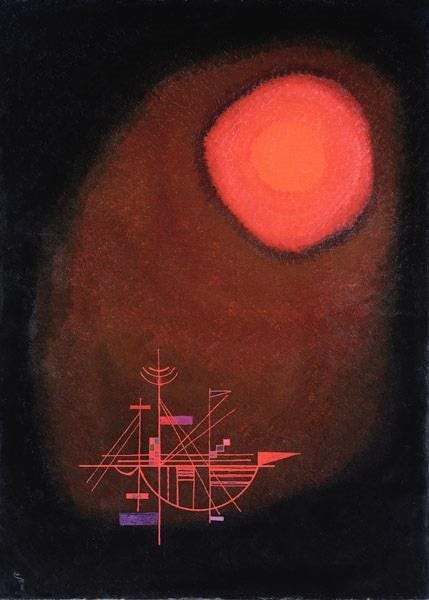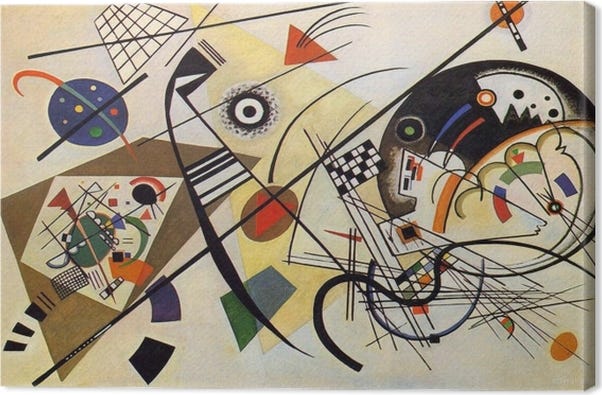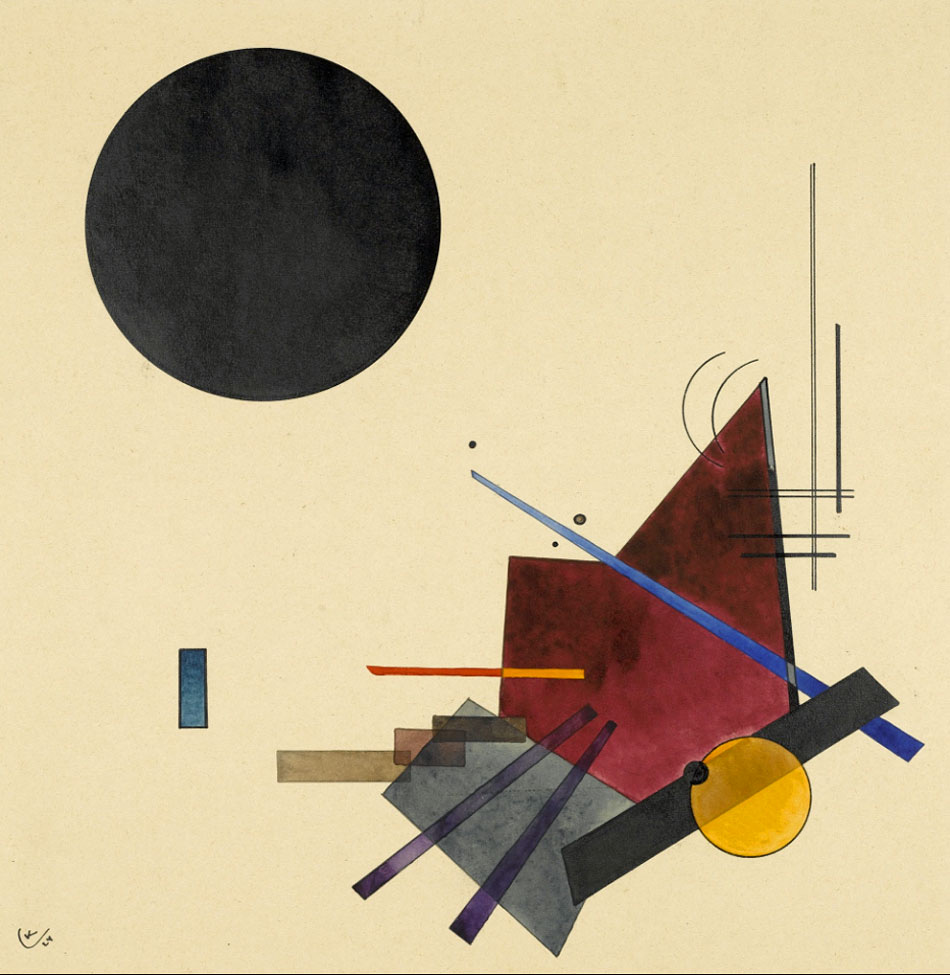I recently (re)read Michel Henry's short book on Wassily Kandinsky and decided to share some thoughts. Henry, through the simplicity of his philosophy, and his never ending pursuit to remind us of that which is most important, never fails to amaze me. This short book in essence states that art is about subjectivity, and all art that disregards the subjective aspect of experience is barbaric in nature and not even worth the name of art. Because of its seemingly banal message, and the intellectual climate (France in the 1980's) in which it was written, it was often accused of being reactionary. But this aspect is precisely its strength. A culture that has lost all notion of inner experience, deserves to be reminded of what it has lost. If this comes off as old fashioned or reactionary, this is not because of the message of the text, but because of the impoverished nature of the culture that reads it. As Henry constantly reminds us, the philosophy of subjectivity still needs to be written. For when one looks around at our culture, it is only underground that one finds it. In the near future I will probably write some more texts on Henry's philosophy, this present text might function as an introduction.
I will be referencing the French editions of Henry's works. Translations to English are mine. For those interested, there are however good English translations of nearly all his works in print.
I.
In Voir l'invisible (1988), French philosopher Michel Henry explains his phenomenology of Life by way of Kandinsky's art. According to Henry, this artist tried to express through his art what Henry had been seeking to express throughout his career by means of philosophy. This is: invisible Life, the essence of manifestation. For both Henry and Kandinsky, the appearing of things is marked by a certain duality. The things that appear to us do so simultaneously in two different ways. There is the appearing of a thing as an object in the world, characterised by exteriority and a difference that separates the thing from every other thing and from the world in which it appears. This way of appearing as objects is however only possible on the basis of a different way of appearing, one in which things do not appear as objects, but as subjective affects characterised by interiority and unity.
For Kandinsky, a certain color has a physical effect on the eye: a blue object excites the nerves of the eyes resulting in the organism seeing, but the color also has a psychical effect that directly affects the soul, without needing the intermediary of physical mechanism. For both Henry and Kandinsky, the purpose of art is the expression of this internal way of appearing, this by way of abstraction. Kandinsky firmly believed that abstraction could show things as pure affects, and separate this way of appearing from the object-appearing that usually covers over the primordial internal appearing.
This does not mean that art only finds its essence with the invention of what we designate as abstract art. For Henry, all painting is abstract, and this was the case before the invention of modern abstract art. Henry and Kandinsky use this idea to unleash a violent critique on modern art, its problem is not abstraction, but the fact that it isn't abstract enough. That is, it only expresses the appearing of objects in a world characterised by exteriority, but fails to express the internal appearing. Modern art, seeing only objects, has lost sight of Life.
II. External and internal appearing
"Every appearance can be experienced in two ways. These two ways are not arbitrarily connected to the appearance — they are derived from the essence of the appearance, from two ways in which appearing happens: External — Internal." (Kandinsky, Punkt und Linie zu Fläche, 11).
For Michel Henry, Western thought suffers from what he calls ontological monism. Such a monism posits, explicitly or implicitly, that there is only one in which things are, only one way in which things appear. This way of appearing is as things outside of us. Something can only appear because it is appearing outside of us, because there is a distance between subject and appearance. Husserl expresses this ontological monism in the thesis that all consciousness is characterised by intentionality. All consciousness is consciousness of some-thing, of some-thing outside of consciousness.
Henry attacks this thesis, stating that there is also a different way of appearing prior to intentionality. For Henry there is a way of appearing in which there is no distance between consciousness and phenomenon, a way of appearing in which the consciousness of appearing and appearance are one and the same. Phenomenality as such.
This appearing shows itself in affectivity. There are affective experiences of such an intensity that there is no longer a difference between the consciousness of the feeling and the feeling itself. There are feelings of pain, of love, of cold, that completely dissolve any distinction between subject and phenomena. There are thus two ways of appearing: the ek-static appearance of something outside of me in intentionality, in which consciousness transcends itself towards the object, and the non-intentional and wholly immanent appearance of something as me in affectivity. In pure affectivity there are no things, only affects, and there is no distance, only a crushing nearness.
"Immanence is the essence of transcendance." (Michel Henry, L'essence de la Manifestation, 309).
This immanent appearing is also the essence of all appearing, and thus makes possible all ek-static appearing. Immanent affectivity is the ground that makes the appearance as things outside of us possible, it is the phenomenological Absolute, that Henry designates as Life.
Henry's fascination with Life makes him look at Kandinsky. The latter too recognised a duality of appearance. Kandinsky characterised the internal affective appearing as abstract, because it is void of any reference to the world of things in which every things derives its meaning from its relation to other things and the world in which it appears. In his On the Spiritual in Art, Kandinsky states that something can affect us in two ways. These two ways correspond to both external and internal appearing.
When I feel love for someone, there is a physical way in which this person affects me. The sight of the person excites my brain, releasing all sorts of chemicals, my legs shake, my hands sweat etc. When the person (and the thought of this person) goes away, these things disappear too. In this case, the love affects me just like objects affect objects. But there is also a more direct way in which the feeling of love affects me, constituted by the subjective experience the love brings forth in my soul. These appearances are invisible and have nothing to do with me as a physical body. They also don't just go away when the person and the thought of the person go away, they quasi-permanently transform me as a person. I am a different person because of this experience, and there is no turning back.
These transformative appearances that affect people in direct ways are, for Kandinsky, the object of art. These appearances affect us with such a nearness and intensity, that can never be achieved by external appearing, precisely because of the distance the latter presupposes.
These, inner, 'abstract', affects make up the palette of Kandinsky's art. All phenomena have this duality, and as such all colours have a duality too. The color red has an external quality on the canvas, as a section of matter that takes up a certain space, but it has an internal quality through the affects that it brings up in a person. The colours that Kandinsky happens to choose for a particular painting are decided on through his principle of Inner Necessity. This principle states that the choice of colours should be completely determined by the force of their abstract/internal contents.
III. Radical subjectivity
Guided by the principal of internal necessity, the artist expresses subjective Life. This does not mean that he merely expresses feelings. The artist doesn't paint the feelings that a certain object excites in me: sadness, happiness, grief, etc. For Henry and Kandinsky, there is a radical difference between subjectivity in its radical immanence, and feelings concerning certain states of affairs. The latter are marked by a rest of exteriority and intentionality, and thus fail to express the immanent and pre-intentional Life. Feelings concerning certain phenomena in the world presuppose a distance between subject and object, constituted in intentionality.
In this intentional scheme, subjectivity is simply the condition of possibility of the phenomena in their exteriority. How we define subjectivity is based on the external. What is the subject one asks? The transcendental ground of phenomena, the subjective ground of object-ivity. Thus, in intentionality, subjectivity is completely modelled on the appearance of objects, and its essence is reduced to being conscious of objects. Subjectivity doesn't find its essence in itself, but in the object, precisely because it is nothing more than that which makes the perception of the object possible.
This way of defining subjectivity that plagues Western thought is what Henry rejects. It only gives us a negative definition of subjectivity, and reduces it to an object. Because, if all consciousness is intentional, it follows that all knowledge is intentional. All knowledge is knowledge of something other than what is knowing itself. When we then try to know subjectivity, we know it as an object, as a thing in the world, whose essence is defined by its relations to other things. We thus never define subjectivity by what it is, but only by what surrounds it, and we fail to grasp the pre-intentional essence of subjectivity.
To explain this pre-intentional subjectivity, Henry practices a form of Cartesian doubt. I can always doubt the existence of the objects that excite feelings in me. I can also doubt what my feelings are (is this really sadness? is this truly pain? is this what love feels like?), but I can never doubt that I feel. This is radical subjectivity. Subjectivity, not in relation to objects, but in its radical affective immanence as the indubitable essence of subjectivity. This subjectivity doesn't find its certainty in the world, but in itself, in Life. According to Henry, it is this radical layer of subjectivity that Kandinsky yearns to express through his principle of inner necessity. The demand to express this type of subjectivity is categorical for Kandinsky. The expression of mere intentional feelings of certain people in certain historical times does not follow this principle, and can even be considered a crime for Kandinsky. A waste of energy that in the name of art draws us towards the world, instead of bringing us closer to Life.
III. Culture and Life
"Painting makes one see not insofar as it shows what one has never seen before [...] it makes one see insofar as it returns vision to itself, increases its capacity to see, in the intensification of its pathos and through it." (Henry, Voir l'invisible, 210).
For Henry and Kandinsky, the success and greatness of art is determined by the degree to which the artist is able to express pre-intentional subjectivity. For Kandinsky, the content of "The pure and eternal art is the objective element, which uses the subjective to become understood." (On the Spiritual in Art, 56). The artist can't escape his own subjectivity, he can only express his own feelings and affects. What separates a great from a mediocre artist is the way in which the great artist is able to express the pre-intentional core of these affects: Life in its pre-intentional immanence. Because art expresses Life, the pre-intentional essence of our lives, it brings us closer to the essence of ourselves.
The artist has a responsibility. In our world, people often turn away from the deepest layers of subjectivity, hardly sensing that there even is such a thing, and philosophers deny subjectivity: has madness ever expressed itself in a more laughable way? A condition that Henry designates as Barbarism: life turning against Life. Why do we do this? Because life in its subjectivity is not only joy and bliss, but also suffering and intensity. We drug ourselves and turn away, we escape towards the world and get lost in its objects. The artist's task is to force people to look at themselves, to stare Life in the eyes and feel its violent reality as their essence. We live in a world, but our fascination with it can make us forget that this world is also the expression of Life. If this Life is expressed in the creations of men, we can speak of culture, in which our creations are "hieroglyphs of the invisible" (Henry, Voir l'invisible, 244.) If this is not the case, what remains are the depictions of objects in their exteriority. Because these only refer to what is external, they are incapable of affecting us in the immanent intensity that we are, these objects transcend us, and fail to affect the immanence that we are. We are so addicted to the world, that perhaps even the dead are closer to Life.
Sources:
Michel Henry, L'essence de la manifestation. Paris: PUF, 2011.
Michel Henry, Voir l'invisible: sur Kandinsky. Paris: PUF, 2014.
Wassily Kandinsky, Punkt und Linie zu Fläche. München: Verlag Albert Langen, 1926.
Wassily Kandinsky, On the Spiritual in Art. New York: Solomon R. Guggenheim, 1946.






